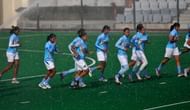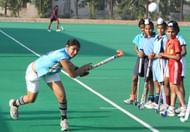Dr. Saju Joseph, as a coach and physical fitness trainer, has contributed a lot to hockey in particular and other sports in general. He has a Ph. D besides a Masters Degree in Physical Education and a Certificate in Coaching (Hockey). He is, at present, a consultant in Sports Science Faculty of National Institute of Sports, Kuala Lumpur, Malaysia. To be precise, he is a Functional Bio-mechanist for hockey and other sports.
He was with the Indian National hockey teams from 1996 to 2005. He is the only person who had worked with both the Indian men & women (senior and junior) teams. The Indian hockey teams under his coaching and training have won Gold medals both in the senior and junior sections on many an occasion. Some of these tournaments are – Pre-Asian Games 4-Nation Hockey Tournament in 1998 at Bangkok; Asian Games in 1998 at Bangkok; Prime Minister’s Gold Cup International Hockey Tournament at Dhaka in 2001; Castrol International Hockey Tournament in 2001 in England; Champions Challenge Hockey Tournament in Malaysia in 2001; Junior Asia cup in 2004 in Karachi and many other junior international tournaments.
Since 2006, Saju Joseph has trained the Malaysian hockey team, which has put up remarkable performance at international level.
An expert in high performance, clinical and rehab issues of sports and sportspersons, Dr Saju Joseph is a versatile and multi-dimensional coach and physical fitness trainer. He has delivered sports lectures at several universities in India, Malaysia and Korea. He is well-versed in advanced training and analysing performance with Isokinetic System, gait and motion analysis, Radar Guns, GPS System. Using advanced software in coaching and analysis, he has imparted training in hockey, golf, cycling, athletics, cricket and swimming.
He is adept in managing gymnasiums. He is an enthusiastic and untiring researcher in sports related areas, a reviewer for prestigious sports journals. He has a vast teaching and training experience. In addition to a number of research articles published in international conferences and journals, he also has two books to his credit.
Here are some excerpts from the interview Sportskeeda had with this versatile sports genius.
You have trained hockey players – men and women, seniors and juniors. Is there any cognizable difference in the way men players and women players respond to your coaching and physical fitness training?
There is a vast difference in training men and women hockey players. The men can digest the daily training routine without much hassle. But the women need to be really pushed to undertake heavier training loads, as they lack in self belief. Moreover, you need to focus on individual basis, due to the menstrual cycle variation in a team. Planning and loading needs to be done carefully due to the wide variation in our Indian culture. Bihar/Orissa girls sincerely respond and adapt to physical training as compared to others in the country.
The contribution of a coach/physical fitness trainer is always crucial and vital. How did you feel when India won the Gold Medal in Junior Asia Cup in 2004 at Karachi?
The preparation for the 2005 Junior World cup and 2004 Junior Asia cup started with a serious note in 2002. Periodisation was drawn, each and every meso & micro cycles were planned with great care and executed at odd conditions and facilities delivered to us. But without any grief, the boys worked hard and gave their best. The victory in Karachi against Pakistan in the Junior Asia Cup final was a very sweet one as we defeated them in their home ground, and in front of a 20,000 odd crowd, with a score of 5-3.
A coach of high caliber like you is always instrumental in the successful performance of a team. Do you think the coach gets all the acclaim and recognition he deserves on par with the team captain or team manager?
Hockey is a team sport. All the officials and players should have like mindedness and a common goal – and should strive to achieve that target. Though as a coach or as a supportive staff, you may not be their in the main picture, but recognition will follow you automatically. At the end, it is the satisfaction that you get as a member of the team in realizing the goals.
Is there much gap between coaching and fitness training standards in India and other countries?
There is difference in coaching standards to a great extent, as our Indian coaches do not believe in video analysis, and does not plan and strategise their game plan accordingly. Most of our coaches believe that by just playing game among the campers – all the elements of technique and tactical development, strategy and team combination will automatically be developed. This is one of the biggest drawback in our preparation for any competition.
The physical fitness training is common all over the world, but we are with limited scientific resources to analyse the physical demand during the game and during the specific training drills. Therefore, most of the time players are not pushed to their optimum limits while training, assuming injury would take place. This limits our performance to a great extent when it matters most.
Indian teams have to play in varied climatic conditions in Australia, Germany, Spain, Poland, France, Switzerland, Holland, America Japan, Malaysia etc. How do you cope with the ‘climate’ factor in coaching and fitness training of the Indian team?
Frankly speaking, adapting to climatic conditions is very essential for a competition. The individuals too respond to varied to climate conditions. It is not just the climate alone but the need to get adapted to the food, bio rhythm and change in time, etc. There are strategies and varied approach through which this can be accomplished. But, with limited resources and support from the government, the teams are just cleared 1 day before the tournament. There have been many occasions we have traveled and played tournaments with jet lag, and to some extent with hardly five hours gap between landing and playing matches.
Are there any great attitudinal differences between Malaysian players and Indian players?
Certainly there are many attitudinal differences. Indian players, if they get a ball and some space to play – they train even without a coach and it is vice versa in Malaysia. But Malaysian players, when they are on the ground, they are united as a team and have a strong bound among themselves. In India, our players classify themselves as south and north and also mix among their state players only. This division is clearly visible when any selection trials takes place.
You have the vast and varied experience of coaching not only hockey players but also footballers, cricketers, kabaddi players, swimmers, etc. Can you say which gave you the ‘utmost’ satisfaction?
For me, each training session carried out is satisfaction whether it is for athletes with different level of performance or gender or status of sports in relation to the society. I don’t give any special preferences to any sportsman or any sport, but look up to them as individual and specific performers who needs the right training. But I feel elevated to a kind of extreme happiness, when the athletes achieve glory.
Do you adopt any different approaches for different games in analysing technique?
Different sports have different physical, technical and tactical demands. Therefore, the approaches need to be different. For example, in the case of swimmers or synchronized swimmers – we do use underwater camera to analyse their individual technique executions and give suggestions and rectification workout accordingly, so that they could maximise their performance. Based on the technical movements inside water, the training programmes are designed accordingly.
You have specialised in training goal keepers and drag flickers. Do you think further specialised coaching is possible for best performance by Indian hockey players?
Yes. Most of the Indian flickers and goalkeepers train isolated. There is no specific training which is done by them, other than the coach giving shooting drills to goalkeepers or asking the drag flickers to train in quantity. There is no quality feed back for each save or goal conceded for goalkeeper or a goal scored or quality and issues of the flick in case of a drag flicker. There needs to be specialized coaching programmes, workshops, clinics and practical sessions for goalkeepers and drag flickers. If any one in the country could come out with a concept of goalkeepers’ academy or drag flickers academy – it would do a lot good for Indian hockey.
By virtue of your competent coaching and physical fitness training, India has won Gold, Silver and Bronze medals on many an occasion. Are you optimistic about a string of victories for the Indian hockey team even in future?
One thing we need to believe is that Indian hockey can excel in future, as there is no dearth in quality of hockey players, money, job opportunities, domestic hockey tournaments and hockey facilities in India. The issue is the set up of the administration and a system of approach which is to be streamlined. There needs to be a hierarchy in hockey development – in terms of coaching, education, career development, grass root and academies, competitions and age group competitions, seminars, workshops and even creating a benevolent fund. If we have a sound system, there is nothing which can stop us from re-surging.
In the golden era of Dhyan Chand, advanced scientific support, technical coaching and fitness training was absent. What is the secret of hockey highs and heights of those days?
Those days, hockey was an artistic game and we did have skillful hockey players who could do magic on grass. The technique superseded fitness then, on the grass field. The dimensions of the hockey stick and the playing surface assisted the Asians in executing the skills, especially the Indian dribble and dodging skills. The change in the rules of the game, the ground conditions- switching over to artificial turf, the dimensions of the stick (the curve aspect) has considerably effected the natural skill and have turned out to be a fitness and tactical oriented game. The off sides rule made it possible for a player to carry the ball for long then – and tackling was limited moreover to a guess due the grassy and bounce conditions.
The other part of the world woke up and did do a lot of research, ways and means to counter Indian dominance. They worked more on to fitness compensating the skill aspect and training skills which are just basic enough to play the game was concentrated upon. Change in the rules of the game, turf conditions, added technology in coaching and scientific monitoring revolutionized the game and helped them to emerge themselves as hockey power at the same time, the Indian community still salvaged on to their old system and glory.
I am quite sure – if we bring back hockey to natural turf conditions and still sticking on with old rules and regulations of the game we could still excel in hockey. In tennis we have grass court, clay court and artificial court competitions with bare minimum changes in rules of the game from yester years. Why not have the same type of competitions in hockey?


